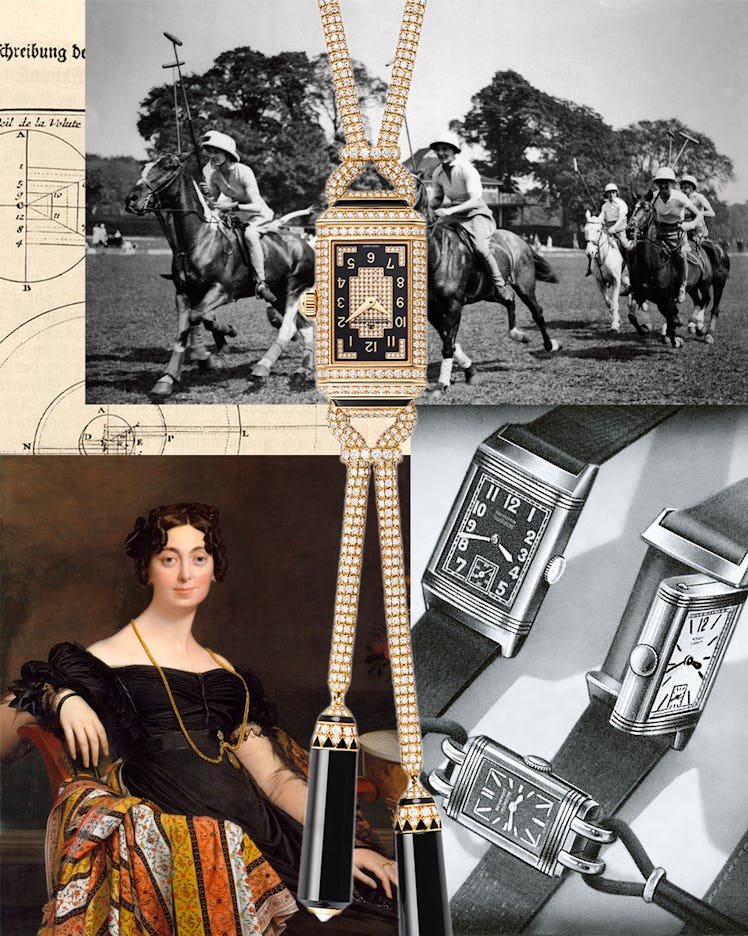A Classic Watch Gets a Glittering Upgrade

Released in 1931 as a men’s polo watch, the Jaeger-LeCoultre Reverso is an Art Deco design classic to rival the Chrysler Building. A gleaming symbol of between-the-wars modernity, the Reverso reflected the artistic and technological innovations of its time. It had a pivoting action that allowed for the case to turn over, keeping the watch protected while the wearer played; a flat metal surface could better resist a whack from a wooden ball than the glass face.
The Reverso wasn’t all about function, though. Its handsome rectangular design was inspired in part by the ancient golden ratio mathematical formula, very much in vogue at the time and considered by many, across centuries, to be the most harmonious and pleasing stylistic proportion. Perhaps that is why the Reverso was one of the company’s biggest sellers and became a crossover hit with women. It has since been launched in various feminine forms, including as a pendant hanging from a black textile cord, so it could be worn as a necklace rather than on the wrist. The watch was positioned upside down so its owner could lift it toward her to tell the time.
Now that classic is being reinterpreted as a riotous diamond-and gem-festooned high-jewelry offering featuring a chain of diamond-set links and onyx beads from which a richly gem-set pink gold case is suspended, anchored by polished charms. Needless to say, the Reverso Secret Necklace, as the new style is being called, conceals a timepiece that can be turned over at the wearer’s discretion; it is a stunning exemplar of luxury that feels very of the moment.
Catharine Lorillard Wolfe Collection, Wolfe Fund, 1918, Image courtesy of The Metropolitan Museum of Art, New York.
Courtesy of Jaeger-LeCoultre.
Keystone-France/Gamma-Rapho via Getty Images.
According to Jaeger-LeCoultre CEO Catherine Rénier, one of a handful of female chief executives in the watch world, the Reverso’s constant updates have helped to keep it relevant, but the key to its success is the unmistakable Deco echo—the timeless design of the case. “The fact that the golden ratio was discussed in the design process was not a coincidence,” Rénier says. “It was the approach.”
Gift of Mrs. Frederick F. Thompson, 1915, The Metropolitan Museum of Art, New York.
Sepia Times/Universal Images Group via Getty Images.
Just as the original was adjacent to the work of leading artists, designers, and craftsmen of the day, the Reverso is being feted as part of the company’s Made of Makers program, in which top artists and creators revisit a theme important to the brand. For a new installment that will be shown at a series of Jaeger-LeCoultre events in key cities around the world, including Singapore, New York, and Zurich, the Korean digital media artist Yiyun Kang has created a 3D video sculpture called Origin, inspired by the Reverso’s connection to the golden ratio, which draws parallels between symmetry in nature and the geometry of Art Deco design.
Courtesy of Jaeger-LeCoultre.
For Kang, who explores the intersection of art and technology in her immersive projects, the commission was a way to examine why humanity has been drawn to the concept of the golden ratio for so long. “Perhaps we are attracted to it because it identifies the origin of life—not just an aesthetic pattern,” Kang muses. Or maybe it’s about taking a pause in these frenetic times. The calming assurance of a world of ordered beauty, especially one that reminds us of time-honored traditions and knowledge, represents, as Rénier puts it, “an anchor in today’s madness.”